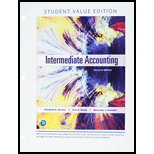
Concept explainers
a.
The original cost of plant asset.
Given information:
Net book value of asset after 10 years is $2,600,000 on Jan 1 of current year.
Expected residual value is $500,000.
Estimated useful life is 25 years.
b.
The annual depreciation for first 10 years.
Given information:
Net book value of asset after 10 years is $2,600,000 on Jan 1 of current year.
Expected residual value is $500,000.
Estimated useful life is 25 years.
c.
To prepare: The
Given information:
Net book value of asset after 10 years is $2,600,000 on Jan 1 of current year.
Revised expected residual value is $100,000.
Revised estimated useful life is 20 years.
d.
To prepare: The footnote disclosure for change in accounting estimate.
Want to see the full answer?
Check out a sample textbook solution
Chapter 21 Solutions
Intermediate Accounting, Student Value Edition Plus MyLab Accounting with Pearson eText -- Access Card Package (2nd Edition)
- Carlisle Manufacturing, which uses a calendar year, purchased a machine for $60,000 on January 5, 2015. It estimates the machine will have a useful life of 10 years and a $6,000 residual value. The machine is expected to produce 250,000 units during its useful life. The actual number of units produced were 22,000 during 2015, 31,000 during 2016, 24,000 during 2017, and 30,000 during 2018. Using the straight-line method, what is the book value at December 31, 2017?arrow_forwardWhat is your capital gains yield on this investment for this financial accounting question?arrow_forwardWhat is the weighted average cost per unit for July on these general accounting question?arrow_forward
- Arden Manufacturing uses process costing. At the beginning of March, there were 1,200 units in beginning inventory, 45% complete. During the month, 9,500 units were started. At the end of March, 600 units remained in ending inventory, 80% complete. How many units were completed during the month of March?arrow_forwardA warehouse with an appraisal value of $145,320 is made available at an offer price of $168,750. The purchaser acquires the property for $40,500 in cash, a 90-day note payable for $26,500, and a mortgage amounting to $62,900. What is the cost basis recorded in the buyer's accounting records to recognize this purchase? a) $168,750 b) $145,320 c) $129,900 d) $121,460arrow_forwardEvergreen Manufacturing uses a job-order costing system. The company estimates: Total direct labor hours for the year: 120,000 • Fixed manufacturing overhead: $600,000 Variable overhead rate: $2.50 per direct labor hour Job 307 details: Direct labor hours for the job: 80 Direct labor cost: $6,000 • Direct materials used: $950 What is the total job cost for Job 307?arrow_forward
 Intermediate Accounting: Reporting And AnalysisAccountingISBN:9781337788281Author:James M. Wahlen, Jefferson P. Jones, Donald PagachPublisher:Cengage Learning
Intermediate Accounting: Reporting And AnalysisAccountingISBN:9781337788281Author:James M. Wahlen, Jefferson P. Jones, Donald PagachPublisher:Cengage Learning College Accounting, Chapters 1-27AccountingISBN:9781337794756Author:HEINTZ, James A.Publisher:Cengage Learning,
College Accounting, Chapters 1-27AccountingISBN:9781337794756Author:HEINTZ, James A.Publisher:Cengage Learning,

